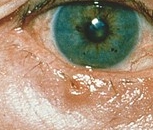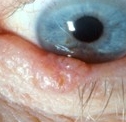Eyelid Cancers
Basal cell carcinomas are the most frequent type of malignant tumor to affect the eyelid, making up 85% to 95% of all malignant eyelid tumors. They are most commonly found on the inner portion of the lower eyelid, particularly in elderly, fair-skinned people. Prolonged exposure to sunlight seems to be a risk factor for developing this form of tumor.


There are many different kinds of basal cell carcinomas, but the nodular variety is one of the most common. It appears as a raised, firm, pearly nodule with tiny, dilated blood vessels. If the nodule is in the eyelash area, some lashes may be missing. The nodule may have some superficial ulceration and crusting and may resemble a chalazion or stye. While these tumors are malignant, they rarely spread elsewhere in the body. For most of these tumors, surgery is the most effective treatment. In severe cases when the tumor has been neglected for a long time, it can spread into the eye socket, which may ultimately require removal of the eye and adjacent tissue.
Depending on the nature of your eyelid tumor, your ophthalmologist (Eye M.D.) may suggest one of many possible procedures to remove the tumor, including normal surgical excision, microsurgery, or cryosurgery. You should discuss the various options and their advantages and disadvantages with your ophthalmologist.
Eyelid surgery to remove the tumor and repair the eyelid is usually an outpatient procedure performed under local anesthesia. Risks of surgery are rare, but asymmetry of the eyelids is one possible complication. After eyelid surgery, bruising or a black eye is common, but it resolves quickly. It may be difficult for you to close your eyelid completely, making the eye feel dry. This irritation generally disappears as you heal. Serious complications are rare but can include vision loss, scarring, and infection.
Squamous cell carcinoma is a malignant eyelid tumor, occurring in approximately 5% of malignant eyelid tumors. The most common location is the lower eyelid, particularly in elderly, fair-skinned people. This tumor appears as a raised nodule, and it can lead to loss of eyelashes in the involved area. When detected and treated early, the outcome for this type of tumor is excellent. However, if the tumor is neglected, it can spread to the lymph nodes in the neck. Surgery is the most effective treatment.
Sebaceous cell carcinoma is a type of tumor that originates in the eyelid glands of elderly individuals. It is relatively rare but still accounts for 1% to 5% of malignant eyelid tumors. These highly malignant tumors may recur, invade the eye socket, or spread to the lymph nodes. The tumor may look like a chalazion or stye, making it difficult to diagnose. Immediate surgical intervention is usually necessary for this type of tumor. In some cases, radiation therapy may be an alternative or may be used in conjunction with surgery.
